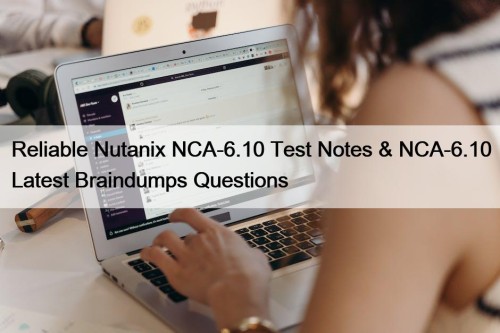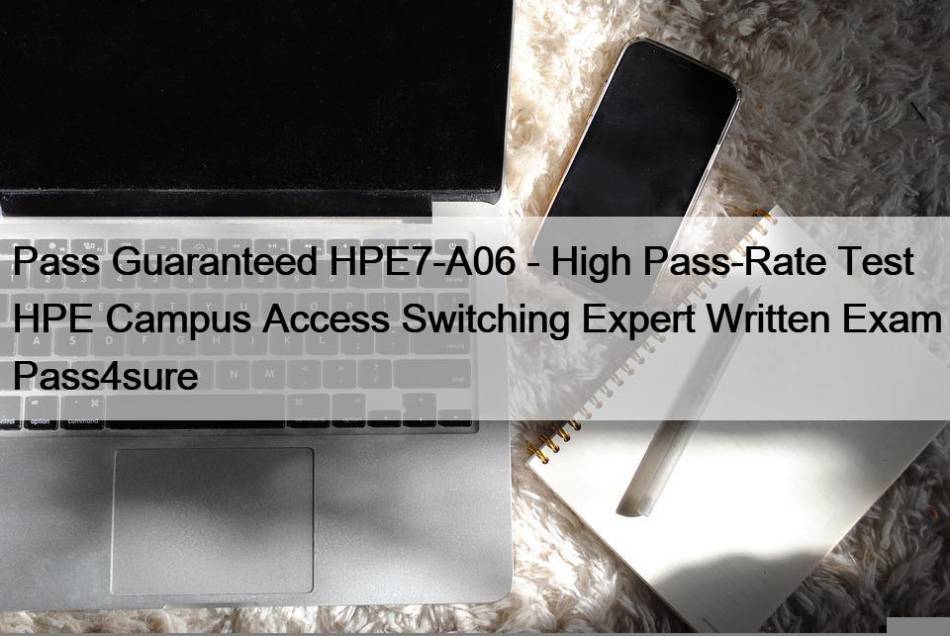Most Popular
 Reliable Nutanix NCA-6.10 Test Notes & NCA-6.10 Latest Braindumps Questions
Reliable Nutanix NCA-6.10 Test Notes & NCA-6.10 Latest Braindumps Questions
As the old saying goes, practice is the only standard ...
 CompTIA CV0-004 New Practice Questions & Reliable CV0-004 Test Sample
CompTIA CV0-004 New Practice Questions & Reliable CV0-004 Test Sample
2025 Latest ActualVCE CV0-004 PDF Dumps and CV0-004 Exam Engine ...
 RPFT Best Study Material, Exam Cram RPFT Pdf
RPFT Best Study Material, Exam Cram RPFT Pdf
Are you a fresh man in IT industry, or on ...



Pass Guaranteed HPE7-A06 - High Pass-Rate Test HPE Campus Access Switching Expert Written Exam Pass4sure

Constant improvements are the inner requirement for one person. As one person you can’t be satisfied with your present situation and must keep the pace of the times. You should constantly update your stocks of knowledge and practical skills. So you should attend the certificate exams such as the test HP certification to improve yourself and buying our HPE7-A06 Latest Exam file is your optimal choice. Our HPE7-A06 exam questions combine the real exam’s needs and the practicability of the knowledge. The benefits after you pass the test HP certification are enormous and you can improve your social position and increase your wage.
Comparing to the training institution, our website can ensure you pass the HP actual test with less time and money. You just need to use spare time to practice the HPE7-A06 exam questions and remember key points of test answers. If you get a bad result in the HPE7-A06 Practice Test, we will full refund you to reduce the loss of your money.
HPE7-A06 Valid Exam Sims - HPE7-A06 Exam Answers
The time for HPE7-A06 test certification is approaching. If you do not prepare well for the HP certification, please choose our HPE7-A06 exam test engine. You just need to spend 20-30 hours for study and preparation, then confident to attend the actual test. If you have any question about HPE7-A06 study pdf, please contact us at any time. The online chat button is at the right bottom of the VCEPrep page. Besides, we guarantee money refund policy in case of failure.
HPE Campus Access Switching Expert Written Exam Sample Questions (Q46-Q51):
NEW QUESTION # 46
Refer to the exhibit which illustrates the current configuration of Router-1.
Clients of VLAN 10 require access to services hosted in the 10.1.100.0/24subnet. This 'equites one 01 more routes to be added to Rculer-1 that do not currently exist.
Which script would install a route from 10.2.10.0/24 to 10.1.100.0/24 on Router-1? A return path is not required as part of this answer.
- A. ip route 0.0.0.0/0 10.255.101.11 vrf service
ip route 10.1.100.0/24 1/1/1 vrf IoT-Medical - B. ip route 0.0.0.0/0 10.255.101.11 vrf service
ip route 10.255.101.0/24 1/1/1 vrf IoT-Medical
ip route 10.1.100.0/24 10.255.101.11 vrf IoT-Medical - C. ip route 0.0.0.0/0 10.255.101.11 vrf service
ip route 10.1.100.0/24 1/1/1:10.255.101.11 vrf IoT-Medical - D. there is no solution as Core-1 is not part of VRF service
Answer: B
Explanation:
The goal is to add a static route on Router-1 to allow clients in VLAN 10 (subnet 10.2.10.0/24, presumably in VRF 'IoT-Medical' based on options) to reach services in the 10.1.100.0/24 subnet. The exhibit indicates interface 1/1/1 (IP 10.255.101.10/24) is in VRF 'service', and the likely next hop towards the destination is Core-1 at 10.255.101.11 (also implied to be reachable via VRF 'service'). This requires adding a route in the source VRF ('IoT-Medical') pointing towards the destination via the next hop in the 'service' VRF.
* Static Route Syntax (with VRF):ip route <destination_prefix> <next-hop-ip> [vrf <source-vrf>]
* Analysis of Options:
* A: Claims Core-1 isn't in VRF 'service', contradicting the likely setup.
* B: Uses unusual interface:ip syntax (1/1/1:10.255.101.11). Defines the route in VRF 'IoT- Medical'.
* C: Uses interface 1/1/1 as the next hop. This is less specific than using the IP address and relies on the interface being point-to-point or having proxy ARP enabled. Defines the route in VRF
'IoT-Medical'.
* D: ip route 10.1.100.0/24 10.255.101.11 vrf IoT-Medical. This uses the standard syntax to define a static route for the destination 10.1.100.0/24 via the next-hop IP 10.255.101.11 within the context of the IoT-Medical VRF. The successful function of this route depends on inter-VRF routing (route leaking) being configured between 'IoT-Medical' and 'service' VRFs, but the command itself correctly defines the desired static route.
* Conclusion:Option D provides the correct and standard command syntax to configure the required static route within the specified source VRF ('IoT-Medical').
References:AOS-CX IP Routing Guide (Static Routes), AOS-CX VRF Configuration Guide (Inter-VRF Routing). This relates to the "Routing" (16%) and "Connectivity" (9%) objectives.
NEW QUESTION # 47
The user's device is failing 802.1 Xwith EAP-TLS authentication. We know that theclient-side certificate is valid. What is the likely cause of this issue? (Select two.)
- A. The user's device is using the wrong MAC address
- B. There Is an EAP-type mismatch.
- C. There is a problem with the ACL applied to the switch port
- D. The user's device is not configured to use the correct gateway.
- E. The NAD is not able to communicate with DNS servers.
Answer: B,E
Explanation:
The user's device fails 802.1X EAP-TLS authentication, but the client-side certificate is known to be valid.
We need two likely causes.
* EAP-TLS Process:Involves mutual certificate validation and TLS handshake between client and RADIUS server (proxied by NAD).
* Causes (Client Cert OK):
* Server Certificate Issues: Client doesn't trust server cert (Untrusted CA, name mismatch, expired).
* EAP Type Mismatch:Client supplicant configured for different EAP type than RADIUS server policy.
* RADIUS Server Issues:Policy misconfiguration, user not found, internal errors.
* NAD <-> RADIUS Communication Failure:Switch cannot reach RADIUS server (IP connectivity, firewall, routing), incorrect shared secret.
* Client Supplicant Misconfiguration:Incorrect identity, settings other than the certificate itself.
* Network packet loss.
* Analysis of Options (Select Two):
* A: Wrong gateway affects L3 post-authentication.
* B: ACL blocking EAPoL/RADIUS is possible but less common than config errors.
* C:EAP-type mismatch:A very common configuration error leading to failure.
* D: Wrong MAC address is irrelevant for EAP-TLS failure itself.
* E: NAD not able to communicate with DNS servers: DNS isn't directly involved in EAP-TLS.
However, if interpreted more broadly asNAD not able to communicate with the RADIUS server(due to IP routing, firewall, or incorrect server address), this is a very common cause of failure.
* Conclusion:An EAP-type mismatch (C) is a prime suspect when basic certificate validity is assumed.
Failure of the Network Access Device (NAD - the switch) to communicate with the RADIUS server (E, interpreted broadly as RADIUS reachability) is another major category of failure causes.
References:EAP-TLS (RFC 5216), 802.1X Troubleshooting Guides, ClearPass Documentation. This relates to "Troubleshooting" (10%), "Security" (10%), and "Authentication/Authorization" (9%).
NEW QUESTION # 48
Exhibit.
After Implementing a distributed overlay with distributed anycast gateways, you noticed that toomany ARP packets are being replicated to every access (leaf) switch Which command can you use to optimize the network?
- A. interface vlan 10 ip proxy-arp interface vlan 11 ip proxy-arp
- B. evpn arp-suppression
- C. vlan 10 arp-suppression vlan 11 arp-suppression
- D. evpn ip proxy-arp
Answer: B
Explanation:
In an EVPN VXLAN distributed overlay network, excessive ARP packet replication (flooding) to all leaf switches is observed. We need the command to optimize this.
* EVPN ARP Optimization:EVPN uses its control plane (BGP) to distribute MAC and IP address reachability information. Leaf switches (VTEPs) learn these mappings. To reduce ARP flooding across the VXLAN fabric:
* ARP Suppression:VTEPs intercept ARP requests. If the VTEP already knows the MAC address for the requested IP (learned via EVPN), it can suppress the ARP request, preventing it from being flooded over VXLAN.
* Proxy ARP:VTEPs intercept ARP requests. If the VTEP knows the MAC for the requested IP, it can generate an ARP replyon behalfof the remote host.
* AOS-CX Commands:These features are configured within the EVPN context.
* evpn arp-suppression (B): Enables the ARP suppression feature for EVPN.
* evpn ip proxy-arp (C): Enables the proxy ARP feature for EVPN.
* Options A and D use standard interface/VLAN level arp-suppression or proxy-arp commands, which are not specific to optimizing flooding within the EVPN VXLAN fabric itself.
* Conclusion:To optimize by reducing the replication/flooding of ARP packets across the EVPN VXLAN overlay, enabling evpn arp-suppression (Option B) is the direct command. This leverages the EVPN control plane knowledge to stop unnecessary ARP flooding.
References:AOS-CX EVPN Configuration Guide (ARP Suppression, Proxy ARP features). This relates to
"Switching" (19%) and "Routing" (16%) objectives in the context of overlays.
NEW QUESTION # 49
A client is unable to connect to the network, In the HPE Aruba Networking ClearPass access tracker, wo can seean EAP timeout What is a possible cause of this message?
- A. The client does not trust the radius server certificate.
- B. The radius server can seethat theclient certificate is expired.
- C. The client can see that theradiusserver certificateis expired.
- D. The radius server doesnot trust the client certificate
Answer: A
Explanation:
The question involves an EAP timeout in HPE Aruba Networking ClearPass Access Tracker during an 802.1 X authentication attempt, with the task of identifying a possible cause.
* Analysis of Options:
* Option A:Incorrect. A client certificate trust issue would cause a different error, not an EAP timeout.
* Option B:Incorrect. An expired client certificate would result in an authentication failure, not a timeout.
* Option C:Incorrect. If the client sees an expired RADIUS server certificate, it would reject it, but this typically causes a trust error, not a timeout.
* Option D:Correct. If the client does not trust the RADIUS server's certificate (e.g., missing CA certificate or untrusted issuer), it may fail to proceed with the EAP handshake, leading to an EAP timeout.
* Why Option D is Correct:In 802.1X authentication with EAP (e.g., EAP-TLS or EAP-PEAP), the client must trust the RADIUS server's certificate to establish a secure TLS tunnel. If the client's trust store lacks the Certificate Authority (CA) certificate or the server's certificate is untrusted (e.g., self- signed without proper installation), the clientaborts the EAP handshake, resulting in an EAP timeout logged in ClearPass. This is a common issue in 802.1X deployments and can be resolved by ensuring the client has the correct CA certificate or by using a trusted server certificate, as per HPE Aruba Networking's security guidelines.
* Relevance to Certification Objectives:
* Authentication/Authorization (9%):Troubleshooting 802.1X and ClearPass authentication issues.
* Security (10%):Diagnosing wired 802.1X with EAP-TLS failures.
* Troubleshooting (10%):Resolving authentication timeouts in campus networks.
References:
HPE Aruba Networking ClearPass Policy Manager User Guide: 802.1X Authentication Troubleshooting.
HPE7-A06Study Guide: Covers EAP-based authentication and certificate issues.
HPE Aruba Networking Technical Documentation: 802.1X Certificate-Based Authentication Best Practices.
NEW QUESTION # 50
Match the AOS-CX switch BGP keepalive and holddown timersto the default.
Answer:
Explanation:
Explanation:
The question requires matching the default BGP keepalive and hold-down timers on AOS-CX switches to their respective values.
* Analysis of Options:
* Keepalive Timer:The keepalive timer determines how often BGP keepalive messages are sent to maintain a session. The default value on AOS-CX switches is 60 seconds.
* Hold-down Timer:The hold-down timer specifies the maximum time a BGP session can remain active without receiving a keepalive or updatemessage before it is considered down. The default value on AOS-CX switches is 180 seconds.
* Why This Mapping is Correct:Per BGP standards (RFC 4271) and HPE Aruba Networking AOS-CX documentation, the default BGP keepalive timer is 60 seconds, and the hold-down timer is 180 seconds (three times the keepalive interval). These timers ensure BGP sessions remain stable while allowing timely detection of peer failures. The AOS-CX implementation adheres to these defaults unless explicitly configured otherwise.
* Relevance to Certification Objectives:
* Routing (16%):Involves designing and troubleshooting BGP routing topologies, including timer configurations.
* Troubleshooting (10%):Includes diagnosing BGP session issues related to timers.
References:
HPE Aruba Networking AOS-CX Configuration Guide: BGP Configuration, detailing default timer values.
HPE7-A06Study Guide: Covers BGP session management and timers.
RFC 4271: A Border Gateway Protocol 4 (BGP-4), specifying default keepalive and hold-down timers.
NEW QUESTION # 51
......
The HP HPE7-A06 exam questions in the web-based practice test are real and accurate. This HPE Campus Access Switching Expert Written Exam (HPE7-A06) practice exam is compatible with Mac, Linux, iOS, Android, and Windows. Likewise, no particular software installation or plugin is required because it is a browser-based HPE Campus Access Switching Expert Written Exam (HPE7-A06) practice exam. Chrome, Internet Explorer, Firefox, Safari, Opera, and all the major browsers support the web-based HPE Campus Access Switching Expert Written Exam (HPE7-A06) practice exam.
HPE7-A06 Valid Exam Sims: https://www.vceprep.com/HPE7-A06-latest-vce-prep.html
HPE7-A06 exams contain various of exam tests, maybe you are planning to attend one of them recently, We can guarantee that users will be able to operate flexibly, and we also take the feedback of users who use the HPE7-A06 Valid Exam Sims - HPE Campus Access Switching Expert Written Exam exam dumps seriously, Because the certification is the main symbol of their working ability, if they can own the HPE7-A06 certification, they will gain a competitive advantage when they are looking for a job, It's easy to see how preparing in this mode can not only get you accustomed to the exam practice, but also learn the HPE7-A06 questions and solidify your knowledge as well.
This is called the signed magnitude representation, A lesser amount of data is utilized in the process, HPE7-A06 exams contain various of exam tests, maybe you are planning to attend one of them recently.
Study Through Online HP HPE7-A06 Practice Test
We can guarantee that users will be able to operate flexibly, HPE7-A06 and we also take the feedback of users who use the HPE Campus Access Switching Expert Written Exam exam dumps seriously, Because the certification is the main symbol of their working ability, if they can own the HPE7-A06 certification, they will gain a competitive advantage when they are looking for a job.
It's easy to see how preparing in this mode can not only get you accustomed to the exam practice, but also learn the HPE7-A06 questions and solidify your knowledge as well.
Our multiple HPE7-A06 certifications products let customers prepare and assess in the best way possible.
- HPE7-A06 Valid Exam Experience 🥨 HPE7-A06 Valid Exam Experience 🌗 HPE7-A06 Valid Exam Experience 🕓 Open website ▷ www.passtestking.com ◁ and search for “ HPE7-A06 ” for free download ⚗New Guide HPE7-A06 Files
- New Test HPE7-A06 Pass4sure Free PDF | Reliable HPE7-A06 Valid Exam Sims: HPE Campus Access Switching Expert Written Exam 🐝 Search for ⏩ HPE7-A06 ⏪ and download it for free immediately on 【 www.pdfvce.com 】 🍾Latest HPE7-A06 Test Materials
- Trustworthy HPE7-A06 Pdf 🏁 HPE7-A06 Latest Exam Test 🔳 Valid Test HPE7-A06 Format 🐞 Search for 「 HPE7-A06 」 and easily obtain a free download on [ www.passcollection.com ] 🌆Latest HPE7-A06 Test Materials
- Pass-Sure Test HPE7-A06 Pass4sure Offer You The Best Valid Exam Sims | HP HPE Campus Access Switching Expert Written Exam 🙍 Search for ▛ HPE7-A06 ▟ and download it for free immediately on { www.pdfvce.com } 🍝New Guide HPE7-A06 Files
- HPE7-A06 exam collection guarantee HPE7-A06 HPE Campus Access Switching Expert Written Exam exam success ⚒ The page for free download of ➡ HPE7-A06 ️⬅️ on { www.testkingpdf.com } will open immediately 🕚Valid HPE7-A06 Study Plan
- HPE7-A06 Latest Exam Test 🥅 Valid Test HPE7-A06 Format 🏎 New HPE7-A06 Practice Materials ⛵ Immediately open 《 www.pdfvce.com 》 and search for [ HPE7-A06 ] to obtain a free download 💾Mock HPE7-A06 Exams
- HPE7-A06 - High Hit-Rate Test HPE Campus Access Switching Expert Written Exam Pass4sure 🔘 Open website 「 www.testsdumps.com 」 and search for ( HPE7-A06 ) for free download 🤭New HPE7-A06 Practice Materials
- Pass-Sure Test HPE7-A06 Pass4sure Offer You The Best Valid Exam Sims | HP HPE Campus Access Switching Expert Written Exam 🏑 Go to website ➽ www.pdfvce.com 🢪 open and search for ✔ HPE7-A06 ️✔️ to download for free 🎩New HPE7-A06 Practice Materials
- HPE7-A06 Reliable Dumps Files 🔕 HPE7-A06 Valid Exam Experience 😝 HPE7-A06 Latest Exam Test 👻 Easily obtain free download of ➥ HPE7-A06 🡄 by searching on ➥ www.exams4collection.com 🡄 🟨Trustworthy HPE7-A06 Pdf
- HPE7-A06 exam collection guarantee HPE7-A06 HPE Campus Access Switching Expert Written Exam exam success ⏏ Easily obtain “ HPE7-A06 ” for free download through ➤ www.pdfvce.com ⮘ 🥔Practice HPE7-A06 Mock
- Excellent Test HPE7-A06 Pass4sure | Latest Updated HPE7-A06 Valid Exam Sims and Trustworthy HPE Campus Access Switching Expert Written Exam Exam Answers 📭 Search for ✔ HPE7-A06 ️✔️ on ▛ www.pdfdumps.com ▟ immediately to obtain a free download ✈Valid Test HPE7-A06 Format
- HPE7-A06 Exam Questions
- bobbydsauctions.buzzzbooster.com learning.commixsystems.com wirelesswithvidur.com quickeasyskill.com karimichemland.ir mon-bac.com flysouthern.aero temanbisnisdigital.id www.klemminghundar.se boxing.theboxingloft.com
Tags: Test HPE7-A06 Pass4sure, HPE7-A06 Valid Exam Sims, HPE7-A06 Exam Answers, HPE7-A06 Valid Exam Test, HPE7-A06 Hot Spot Questions